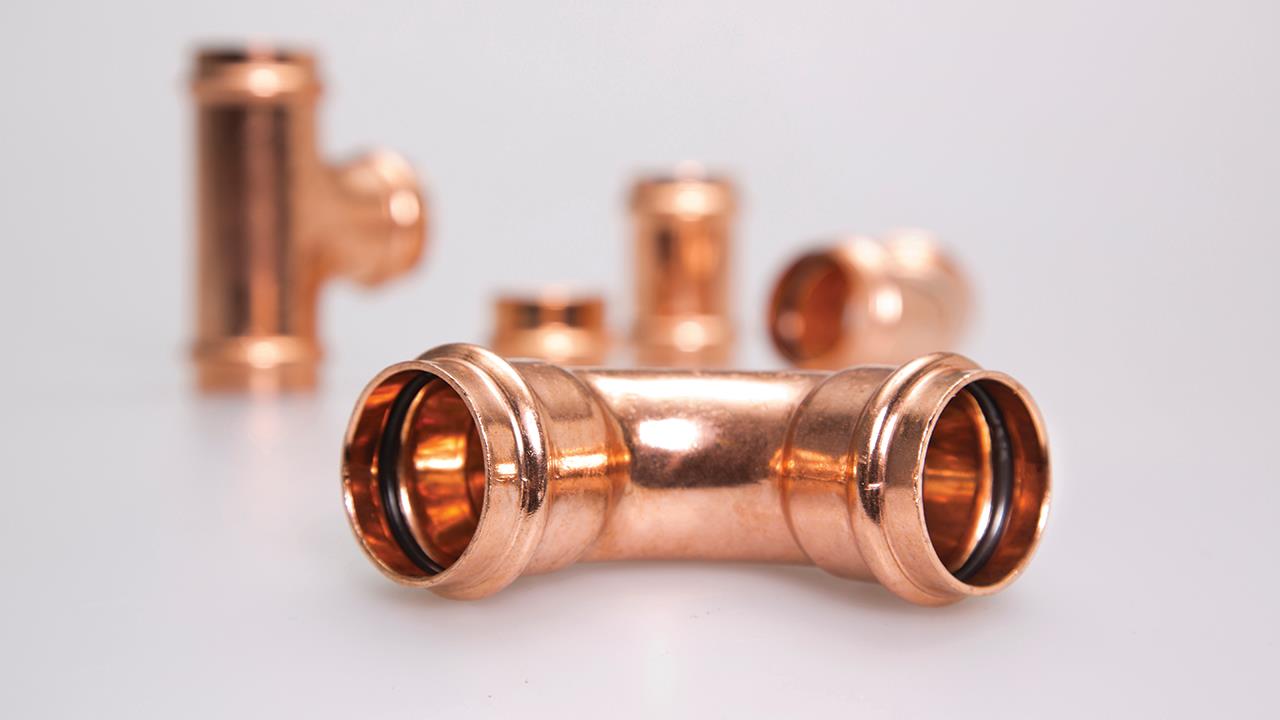

Conex Bänninger has been giving plumbing and heating engineers the opportunity to learn more about >B< Press, the company’s flame-free copper and copper alloy press fittings range, with a series of educational webinars. Here, UK and Ireland Business Unit Director Dan Wild reflects on the sessions held to date and responds to some of the key topics that were discussed.
Applications and technical parameters
>B< Press is a range of fittings suitable for multiple applications, including drinking water, hot water heaters, thermal solar systems, local and district heating, chilled and cooling water and rainwater.
They are quick and easy to install and have been designed with an innovative 3-point press system (up to 54mm) to provide a secure, permanent, leak-free joint.
As flame-free fittings, no brazing consumables are required or a hot work permit, and time-consuming post-brazing fire watches, are negated.
WRAS-approved, >B< Press fittings have an operating pressure of 16 bar at temperatures of up to 110°C.
New way to train
With the use of press becoming ever-more popular in the HVAC-R industry, it is as important as ever that installers have readily available access to information and training, so they can benefit from the advantages this technology offers.
As a largely practical industry, we have been well-used to providing on-site learning. However, circumstances have changed and this now takes place in the digital world.
Far from dampening take-up it has extended the range of opportunities and response to our recent series of >B< Press webinars has been excellent.
In around an hour, through webinars, we’ve been able to offer an insight into the benefits of press, as opposed to traditional brazing methods, show why it has become the pipework jointing method of choice, and include a live workshop demonstration of completing a joint using a press tool.
The opportunity for installers to raise queries and receive a live response has thrown up some interesting questions, a handful of which are highlighted below.
How do I select the correct jaw profile?
During the webinar, installers are guided through the process of achieving a properly pressed joint, and taught the importance of using the correct profile jaw – one that is specific to and matches the fitting type.
Only fully compatible jaws should be used, for example, >B< Press fittings (sizes 12 to 54mm), are installed using jaws with a B profile. Jaws with an M profile should NOT be used with these fittings.
The consequence of using an incorrect jaw set is that the joint will be incorrectly pressed, which will result in either over-pressing or under-pressing. In both cases it is likely to lead to a fitting leak, and will also void the manufacturer’s guarantee.
Installers can check the compatibility of the jaws by referring to its product code or profile markings, and checking this against the tool compatibility chart listed in the >B< Press technical brochure or the website.
How can I tell if I’ve missed pressing a joint?
>B< Press fittings have the advantage of a ‘leak before press’ indicator, which is a feature of the specially designed O-ring. This is designed to show a leak at low pressure (0.1 – 6.0 bar) and identifies if any joint has been missed or wrongly pressed.
It provides installers with a ‘safety net’ and also benefits end-users, as the possibility of faulty joints is minimised.
What’s the benefit of a 3-point press system?
As demonstrated during the presentation, the 3-point press is generated by the fitting having three points of contact during the pressing, or crimping, procedure: one mechanical press each side of the bead and one hydraulic press compressing the EPDM O-ring.
Also, >B< Press fittings have a lead-in edge that ensures the tube can only be inserted squarely and also protects the O-ring. This minimises potential damage to the O-ring.
In summary
The webinars are an excellent introduction to >B< Press and press technology. Once they’ve experienced press the vast majority of installers are converted, appreciating the benefits of reduced installation times and increased productivity, along with improved safety.
Also, the faster speed and predictability of the job in hand gives contracting companies a greater confidence that the task will be completed within the planned timeframe.
For more information on Conex Bänninger’s complete range of fittings and valves, visit www.conexbanninger.com.
Or, if you are interested in attending a future webinar please contact training@ibpgroup.com for details of how to register.
If you'd like to keep up-to-date with the latest developments in the heating and plumbing industry, why not subscribe to our weekly newsletters? Just click the button below and you can ensure all the latest industry news and new product information lands in your inbox every week.